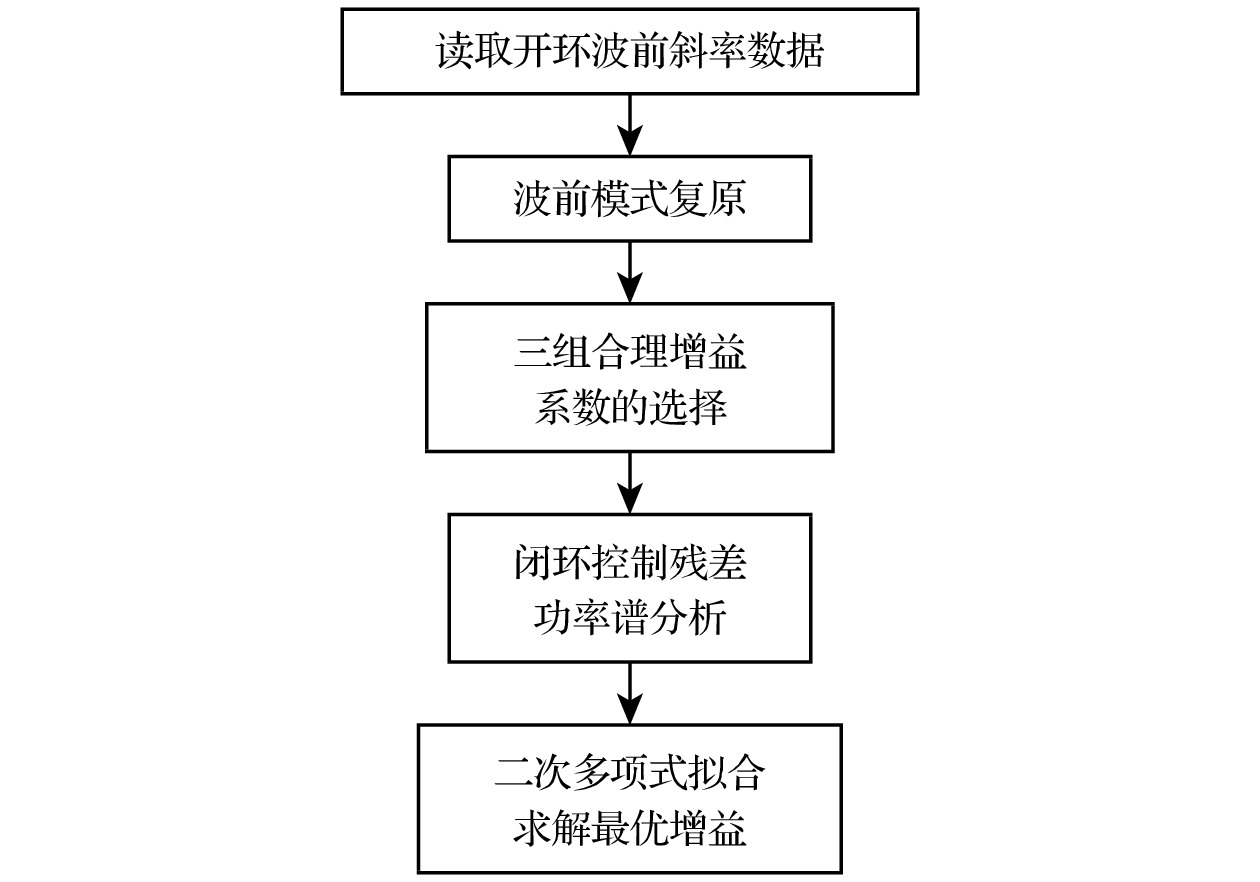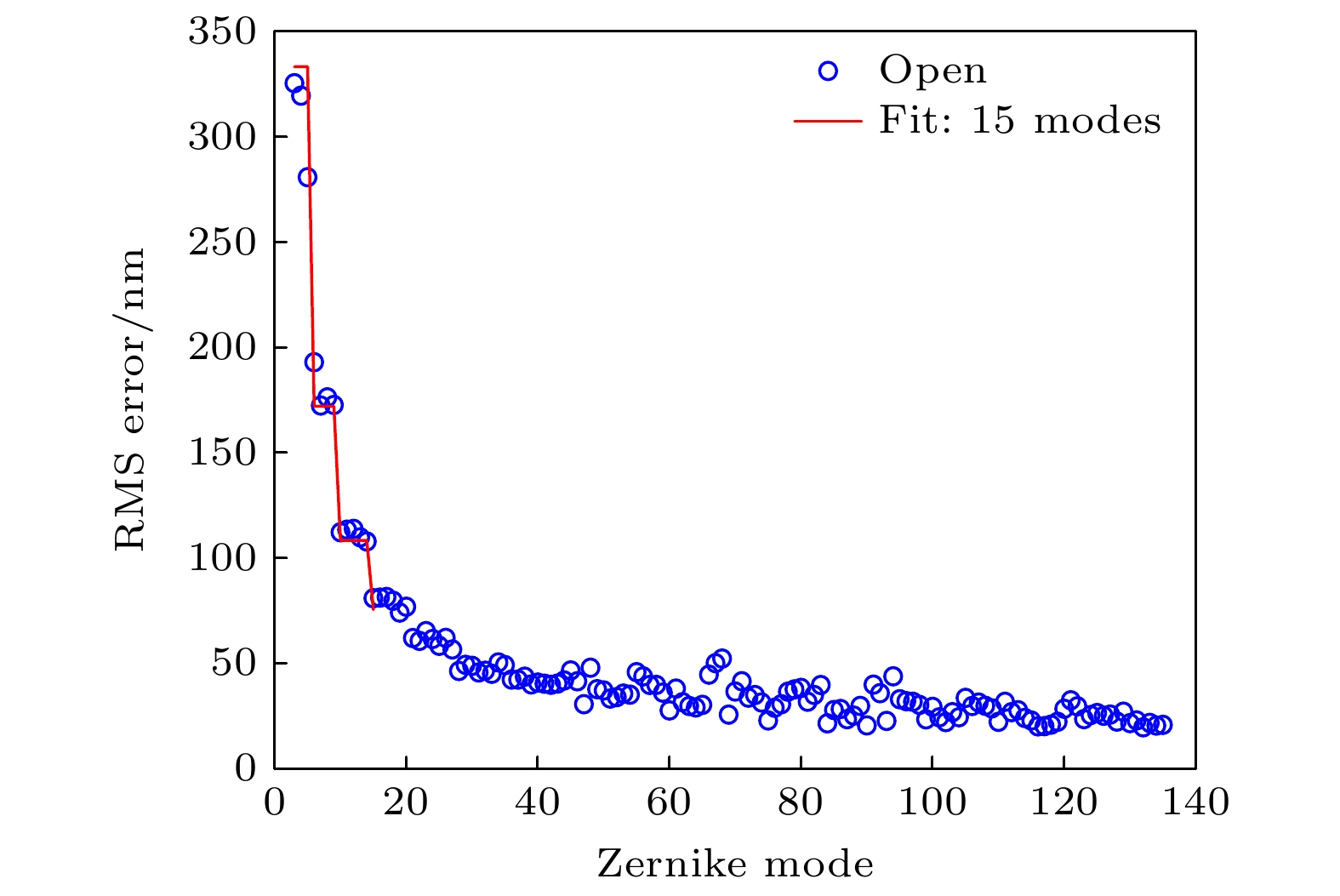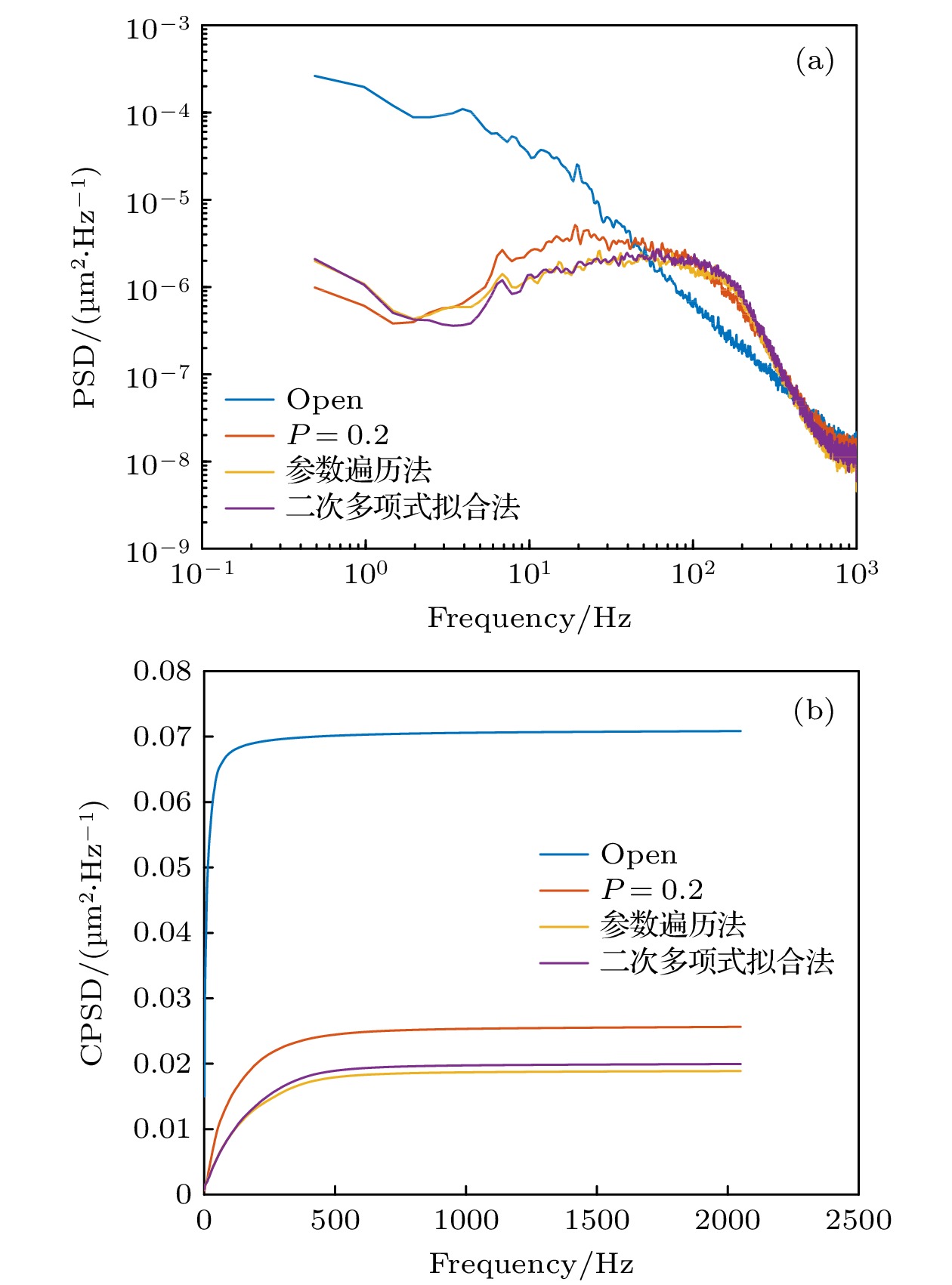-
在自适应光学系统中, 最优模式控制方法首先通过对波前像差进行模式分解, 再分别施加不同带宽的比例积分控制以实现较统一带宽模式控制更优的闭环效果. 最优模式增益通常需要基于自适应光学系统的传递函数模型、实测的扰动和噪声的功率谱密度进行遍历求解获取, 这一过程通常需要较长的时间. 由于大气湍流统计特性的时变性, 所求解的最优模式增益的时效性难以保证. 为此, 本文提出了一种基于二次曲线拟合的最优模式增益快速估计方法, 仅通过3个数据点的闭环残差计算来估计单项模式的最优增益. 仿真和实验结果表明, 所提方法可以较准确地求解最优模式增益, 有效抑制高阶波前像差. 同时, 由于算法的时间复杂度降低, 相比于基于参数遍历的方法, 最优模式增益估计过程所花费的时间缩短了约95.3%, 有利于保证最优模式增益的时效性.In an adaptive optical system, the optimal modal control method refers to applying proportional integral control of different bandwidths to the wavefront aberrations after modal decomposition to achieve better closed-loop results than the unified bandwidth modal control. The optimal modal gain usually needs to be obtained by ergodic solution based on the transfer function model of the adaptive optical system, the measured disturbance power spectral density, and the noise power spectral density, which usually takes a long time. Owing to the time-varying statistical characteristics of atmospheric turbulence, it is difficult to ensure the timeliness of the optimal modal gain. Therefore, we propose a method of fast estimating optimal modal gain based on quadratic polynomial fitting. In the method, it is only necessary to choose three reasonable gain coefficients and calculate their corresponding closed-loop residual errors respectively in order to estimate the optimal gain of single mode. The simulated slope data used in this work are cited from Lijiang 1.8 m adaptive telescope system, which consists of a 241-unit deformable secondary mirror and a Shaker-Hartmann wavefront sensor with 192 sub-apertures, with the first 135-order modes corrected by modal method. Our experiment is to test directly on-line on this system. The results show that under the same atmospheric environment, the proposed method can accurately estimate the optimal modal gain in a very short time and effectively suppress the high-order wavefront aberration. At the same time, owing to the reduced time complexity of the algorithm, the improved optimal modal gain estimation method takes only 0.33 s. Comparatively, it will take 7.08 s to obtain the optimal modal gain coefficient by using the parameter traversal method. Therefore the time spent on obtaining the optimal modal gain is shortened by about 95.3%, which is easier to meet the real-time requirements of the telescope, and beneficial to the adaptive optics system with more high-order modes. For the future adaptive optics system with more than one-thousand units, the proposed method can update the optimal gain to the second level, while the traversal method can only reach the minute level.
-
Keywords:
- adaptive optics /
- wavefront control /
- optimal modal gain
[1] 姜文汉 2018 光电工程 45 7
 Google Scholar
Google Scholar
Jiang W H 2018 Opto. Electron. Eng. 45 7
 Google Scholar
Google Scholar
[2] 饶长辉, 朱磊, 张兰强, 饶学军, 鲍华, 孔林, 郭友明, 钟立波, 马学安, 李梅, 王成, 张小军, 樊新龙, 王晓云, 凡木文, 陈东红, 冯忠毅 2018 光电工程 45 22
 Google Scholar
Google Scholar
Rao C H, Zhu L, Zhang L Q, Rao X J, Bao H, Kong L, Guo Y M, Zhong L B, Ma X A, Li M, Wang C, Zhang X J, Fan X L, Wang X Y, Fan M W, Chen D H, Feng Z Y 2018 Opto. Electron. Eng 45 22
 Google Scholar
Google Scholar
[3] Rao C H, Gu N T, Rao X J, et al. 2020 Sci. China-Phys. Mech. Astron. 63 109631
 Google Scholar
Google Scholar
[4] Luo Q, Huang L H, Gu N T, Rao C H 2012 Chin. Phys. B 21 094201
 Google Scholar
Google Scholar
[5] Guo Y M, Zhong L B, Min L, Wang J Y, Wu Y, Chen K L, Wei K, Rao C H 2022 Opto-Electron. Adv. 5 200082
 Google Scholar
Google Scholar
[6] 宁禹, 余浩, 周虹, 饶长辉, 姜文汉 2009 物理学报 58 4717
 Google Scholar
Google Scholar
Ning Y, Yu H, Zhou H, Rao C H, Jiang W H 2009 Acta Phys. Sin. 58 4717
 Google Scholar
Google Scholar
[7] 李新阳, 姜文汉, 王春红, 鲜浩 2001 光学学报 21 283
 Google Scholar
Google Scholar
Li X Y, Jiang W H, Wang C H, Xian H 2001 Acta Opt. Sin. 21 283
 Google Scholar
Google Scholar
[8] 颜召军, 李新阳, 饶长辉 2011 光学学报 31 0101003
 Google Scholar
Google Scholar
Yan Z J, Li X Y, Rao C H 2011 Acta Opt. Sin. 31 0101003
 Google Scholar
Google Scholar
[9] 颜召军, 李新阳, 饶长辉 2013 光学学报 33 0301002
 Google Scholar
Google Scholar
Yan Z J, Li X Y, Rao C H 2013 Acta Opt. Sin. 33 0301002
 Google Scholar
Google Scholar
[10] Gendron E, Léna P 1994 Astron. Astrophys. 291 337
[11] Gendron E, Léna P 1995 Astron. Astrophys. Suppl. S. 111 153
[12] Dessenne C, Madec P Y, Rousset G 1997 Opt. Lett. 22 1535
 Google Scholar
Google Scholar
[13] Dessenne C, Madec P Y, Rousset G 1998 Appl. Opt. 37 4623
 Google Scholar
Google Scholar
[14] Poyneer L A, Palmer D W, Macintosh B, et al. 2016 Appl. Opt. 55 323
 Google Scholar
Google Scholar
[15] Wang J Y, Guo Y M, Kong L, Zhang L Q, Gu N T, Chen K L, Rao C H 2020 Monthly Notices of the Royal Astronomical Society 496 5126
 Google Scholar
Google Scholar
[16] 王佳英, 郭友明, 孔林, 陈克乐, 饶长辉 2020 激光与光电子学进展 57 230101
 Google Scholar
Google Scholar
Wang J Y, Guo Y M, Kong L, Chen K L, Rao C H 2020 Laser & Optoelectr. Pro. 57 230101
 Google Scholar
Google Scholar
[17] Noll R 1976 J. Opt. Soc. Am. A 66 207
 Google Scholar
Google Scholar
[18] 高玮玮, 沈建新, 李邦明, 梁春 2010 光谱学与光谱分析 30 2232
 Google Scholar
Google Scholar
Gao W W, Shen J C, Li B M, Liang C 2010 Spectrosc. Spect. Anal. 30 2232
 Google Scholar
Google Scholar
[19] 郭友明, 马晓燠, 饶长辉 2014 物理学报 63 069502
 Google Scholar
Google Scholar
Guo Y M, Ma X Y, Rao C H 2014 Acta Phys. Sin. 63 069502
 Google Scholar
Google Scholar
[20] 饶长辉, 姜文汉 1996 强激光与粒子束 8 469
Rao C H, Jiang W H 1996 High Power Laser Partic. Beams 8 469
[21] 李新阳, 姜文汉 2000 光学学报 20 1328
 Google Scholar
Google Scholar
Li X Y, Jiang W H 2000 Acta Opt. Sin. 20 1328
 Google Scholar
Google Scholar
[22] Wei K, Zhang X J, Xian H, Ma W L, Zhang A, Zhou L C, Guan C L, Li M, Chen D H, Chen S Q, Liao Z, Rao C H, Zhang Y D 2010 Chin. Opt. Lett. 8 1019
 Google Scholar
Google Scholar
[23] Guo Y M, Zhang A, Fan X L, Rao C H, Wei L, Xian H, Wei K, Zhang X J, Guan C L, Li M, Zhou L C, Jin K, Zhang J B, Deng J J, Zhou L F, Chen H, Zhang X J, Zhang Y D 2016 Opt. Lett. 41 5712
 Google Scholar
Google Scholar
[24] Guo Y M, Wu Y, Li Y, Rao X J, Rao C H 2022 MNRAS 510 4347
 Google Scholar
Google Scholar
-
表 1 不同增益系数下波前误差RMS值对比
Table 1. Comparison of wavefront RMS value with different gain.
增益系数 开环 0.1 0.2 0.3 0.4 0.5 波前误差 RMS/nm 580.4 109.8 102.6 105.9 118.5 151.6 -
[1] 姜文汉 2018 光电工程 45 7
 Google Scholar
Google Scholar
Jiang W H 2018 Opto. Electron. Eng. 45 7
 Google Scholar
Google Scholar
[2] 饶长辉, 朱磊, 张兰强, 饶学军, 鲍华, 孔林, 郭友明, 钟立波, 马学安, 李梅, 王成, 张小军, 樊新龙, 王晓云, 凡木文, 陈东红, 冯忠毅 2018 光电工程 45 22
 Google Scholar
Google Scholar
Rao C H, Zhu L, Zhang L Q, Rao X J, Bao H, Kong L, Guo Y M, Zhong L B, Ma X A, Li M, Wang C, Zhang X J, Fan X L, Wang X Y, Fan M W, Chen D H, Feng Z Y 2018 Opto. Electron. Eng 45 22
 Google Scholar
Google Scholar
[3] Rao C H, Gu N T, Rao X J, et al. 2020 Sci. China-Phys. Mech. Astron. 63 109631
 Google Scholar
Google Scholar
[4] Luo Q, Huang L H, Gu N T, Rao C H 2012 Chin. Phys. B 21 094201
 Google Scholar
Google Scholar
[5] Guo Y M, Zhong L B, Min L, Wang J Y, Wu Y, Chen K L, Wei K, Rao C H 2022 Opto-Electron. Adv. 5 200082
 Google Scholar
Google Scholar
[6] 宁禹, 余浩, 周虹, 饶长辉, 姜文汉 2009 物理学报 58 4717
 Google Scholar
Google Scholar
Ning Y, Yu H, Zhou H, Rao C H, Jiang W H 2009 Acta Phys. Sin. 58 4717
 Google Scholar
Google Scholar
[7] 李新阳, 姜文汉, 王春红, 鲜浩 2001 光学学报 21 283
 Google Scholar
Google Scholar
Li X Y, Jiang W H, Wang C H, Xian H 2001 Acta Opt. Sin. 21 283
 Google Scholar
Google Scholar
[8] 颜召军, 李新阳, 饶长辉 2011 光学学报 31 0101003
 Google Scholar
Google Scholar
Yan Z J, Li X Y, Rao C H 2011 Acta Opt. Sin. 31 0101003
 Google Scholar
Google Scholar
[9] 颜召军, 李新阳, 饶长辉 2013 光学学报 33 0301002
 Google Scholar
Google Scholar
Yan Z J, Li X Y, Rao C H 2013 Acta Opt. Sin. 33 0301002
 Google Scholar
Google Scholar
[10] Gendron E, Léna P 1994 Astron. Astrophys. 291 337
[11] Gendron E, Léna P 1995 Astron. Astrophys. Suppl. S. 111 153
[12] Dessenne C, Madec P Y, Rousset G 1997 Opt. Lett. 22 1535
 Google Scholar
Google Scholar
[13] Dessenne C, Madec P Y, Rousset G 1998 Appl. Opt. 37 4623
 Google Scholar
Google Scholar
[14] Poyneer L A, Palmer D W, Macintosh B, et al. 2016 Appl. Opt. 55 323
 Google Scholar
Google Scholar
[15] Wang J Y, Guo Y M, Kong L, Zhang L Q, Gu N T, Chen K L, Rao C H 2020 Monthly Notices of the Royal Astronomical Society 496 5126
 Google Scholar
Google Scholar
[16] 王佳英, 郭友明, 孔林, 陈克乐, 饶长辉 2020 激光与光电子学进展 57 230101
 Google Scholar
Google Scholar
Wang J Y, Guo Y M, Kong L, Chen K L, Rao C H 2020 Laser & Optoelectr. Pro. 57 230101
 Google Scholar
Google Scholar
[17] Noll R 1976 J. Opt. Soc. Am. A 66 207
 Google Scholar
Google Scholar
[18] 高玮玮, 沈建新, 李邦明, 梁春 2010 光谱学与光谱分析 30 2232
 Google Scholar
Google Scholar
Gao W W, Shen J C, Li B M, Liang C 2010 Spectrosc. Spect. Anal. 30 2232
 Google Scholar
Google Scholar
[19] 郭友明, 马晓燠, 饶长辉 2014 物理学报 63 069502
 Google Scholar
Google Scholar
Guo Y M, Ma X Y, Rao C H 2014 Acta Phys. Sin. 63 069502
 Google Scholar
Google Scholar
[20] 饶长辉, 姜文汉 1996 强激光与粒子束 8 469
Rao C H, Jiang W H 1996 High Power Laser Partic. Beams 8 469
[21] 李新阳, 姜文汉 2000 光学学报 20 1328
 Google Scholar
Google Scholar
Li X Y, Jiang W H 2000 Acta Opt. Sin. 20 1328
 Google Scholar
Google Scholar
[22] Wei K, Zhang X J, Xian H, Ma W L, Zhang A, Zhou L C, Guan C L, Li M, Chen D H, Chen S Q, Liao Z, Rao C H, Zhang Y D 2010 Chin. Opt. Lett. 8 1019
 Google Scholar
Google Scholar
[23] Guo Y M, Zhang A, Fan X L, Rao C H, Wei L, Xian H, Wei K, Zhang X J, Guan C L, Li M, Zhou L C, Jin K, Zhang J B, Deng J J, Zhou L F, Chen H, Zhang X J, Zhang Y D 2016 Opt. Lett. 41 5712
 Google Scholar
Google Scholar
[24] Guo Y M, Wu Y, Li Y, Rao X J, Rao C H 2022 MNRAS 510 4347
 Google Scholar
Google Scholar
计量
- 文章访问数: 5929
- PDF下载量: 239
- 被引次数: 0














 下载:
下载:














